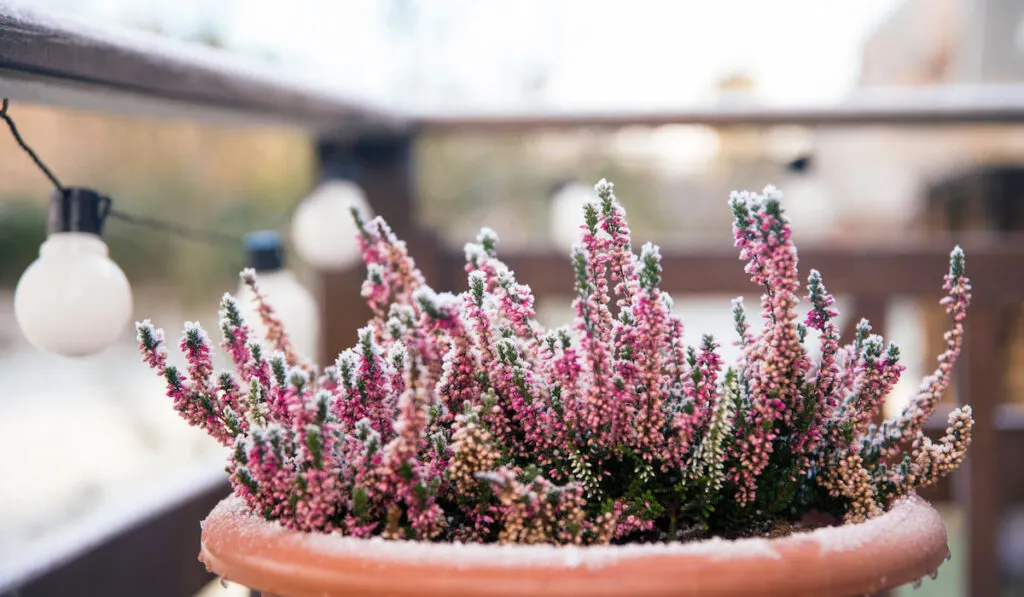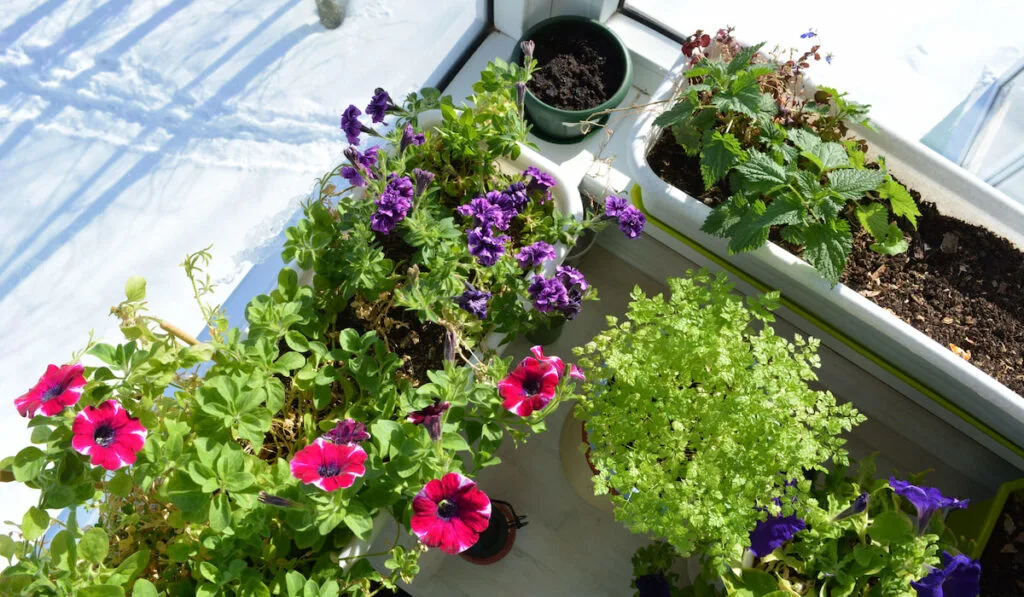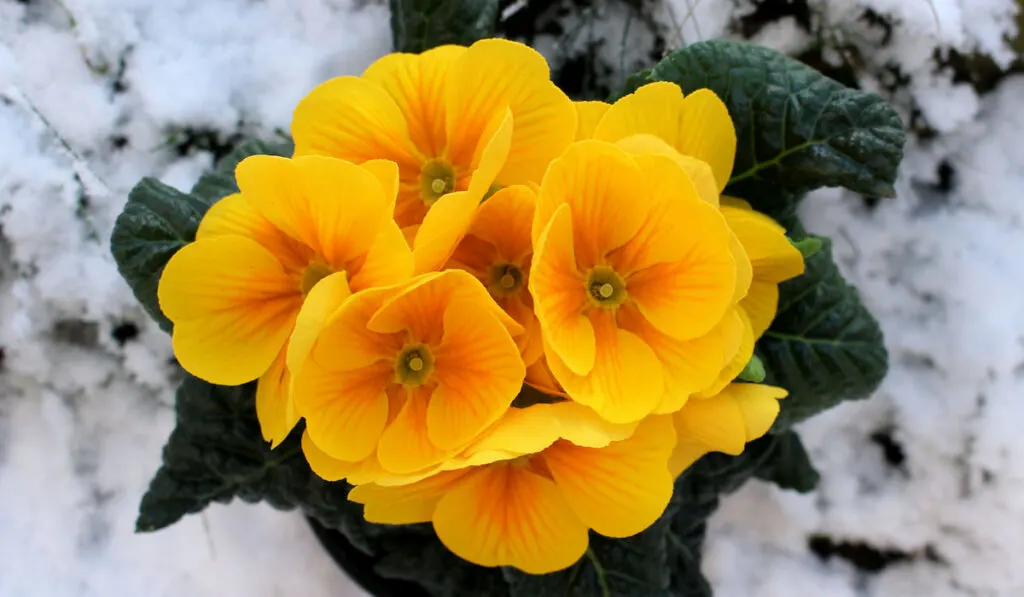If you love flowers, chances are, you want to grow them inside and outside your house. Indoor houseplants are protected from all the elements, including extreme weather and temperature fluctuations.
Flowering plants that grow outdoors are exposed to many things, such as scorching sun, a sudden humidity rise, and even extreme drops in temperature.
You might say that shady areas are more than enough to protect your flowers from the sun. But something is missing in that equation.
What about cold seasons or chilly nights with strong winds? Can your flowers withstand these types of weather?
Generally speaking, how cold is too cold for flowers to be outside?
With the exception of frost-tolerant flowering plants, the lowest temperature most flowers can withstand is 45°F (7.22°C). Anything below this temperature can significantly impair their biological processes to the point of killing them.

Table of Contents
How Do You Know if Your Flowers Are Too Cold?
As with any other issues related to growing plants, there are always some tell-tale signs to look for when the cold weather is affecting your flowers. They might not appear obvious or peculiar.
It’s always in your best interest to look closely for these signs. For instance:
Sponge-like Stems
In any flowering plant, stems act as backbones that hold their overall structures. Since they are responsible for providing support, stems should always feel rigid and firm.
Cold weather can soften the stems of your flowers.
The stem will have a sponge-like structure due to nutrient and water loss. This chain reaction can destroy their cell walls, causing their stems to become flaccid.
Stem Splitting
Water exists in every part of a plant. And according to the law of physics, cold temperatures can cause water molecules to shrink and freeze.
As water freezes, it will turn into a crystal form or ice.
This physical change of molecules can rupture the stem walls, causing splits or cracks.
Over time, when the temperature rises, water from inside the cells can easily escape, leading to dehydration and the death of your flowers.

Wilted Leaves
You might think that only hot seasons can cause dehydration, which leads to wilted leaves. But water and moisture loss can also happen when the environment is too cold.
Similar to how water molecules turn to ice inside the stem, water inside the leaves can also freeze and crystallize, damaging cell walls.
Normal and healthy leaves will have vibrant colors and firm textures. But wilted leaves will appear dull with curly edges.
Excessive Moisture
Unless you just misted or watered your flowers, that water won’t stay for long on the plants.
Most of the time, water dissipates through evaporation, especially in hot weather. Your plants also absorb the water slowly.
However, when the weather is too cold and evaporation doesn’t happen, water that’s already inside the leaves can turn to ice.
In turn, condensation will occur, causing excessive moisture to form and freeze on the surface of the leaves.
Leaf Discoloration

Different varieties of flowers may have different leaf colors. The only difference is how vibrant or lush their appearances are.
Most flowering plants will have green leaves filled with thousands of chlorophyll-containing cells. This natural compound or pigment is the only thing responsible for making the leaves green.
But when the surrounding temperature is too cold, cells inside the leaves can be destroyed, including those responsible for producing chlorophyll.
Over time, more chlorophyll-producing cells are being destroyed. As a result, yellow or brown blotches will appear on the leaves’ surface.
These irregular marks can sometimes appear darker, looking like black spots.
Root Ball Damage
The root ball is the underground structure that holds the entire weight of a flower. Aside from absorbing water and all the nutrients, a healthy root ball is important during transplantation.
In a frigid environment, the root ball slowly degrades before it starts to become loose and fragile. As a result, it can’t anchor your plant firmly to the ground.
If your flowers begin to grow crookedly or aren’t standing firmly in the ground, there’s a higher chance that the root ball has disintegrated.
The trickiest part in knowing whether your flowers are too cold is that you might mistake them as symptoms of other problems.
But what you can do to make things easier is create a checklist.
If more than three or four symptoms are showing, you know the cold environment is slowly killing your flowers.
5 Tips for Protecting Flowers During a Sudden Cold Snap
It goes without saying that cold weather will always be around. But there are many preventive measures that you can take to protect flowers during a sudden cold snap. For instance:
Move Flowers Indoors

You need to be vigilant and aware whenever the weather starts to get colder than usual, especially when the cold season comes.
The easiest way to protect flowers that grow in pots and containers is by moving them inside.
If you don’t have enough space indoors, you can place them in your garage or a shed in your backyard. The best type of shelter is a structure with at least two or three walls.
A roofed structure without walls isn’t enough to protect the flowers from winds and other moving elements.
Use Protective Covers
If your flowers grow in the ground, transplanting or trying to remove and regrow them in other places would be a big hassle. So, use protective covers to prevent these plants from a sudden cold snap.
You can use different covers such as bed sheets, old blankets, pillowcases, cardboard boxes, plastic sheets, and more.
As long as these covers are breathable, you can avoid moisture build-up that can lead to other issues. When the temperature starts to get warmer, remove the covers.
Keep the Soil Moist

You might have the assumption that water can freeze and turn to ice. But underground, water acts as an insulator that can prevent the soil from freezing.
Choosing the right time to water your plants plays a big role in preventing the soil from retaining too much moisture.
Avoid watering your plants in the early morning or late evening when the sun isn’t visible.
A warm or sunny afternoon would be the most favorable period of the day, especially during cold and windy seasons.
Mulch
You can add mulch or manure to trap heat better than natural soil. When the soil is too porous, moisture and water can easily escape.
Conversely, adding too much mulch can make the soil freeze more quickly, and you will end up suffocating the plant. The key is to find the right balance or ratio between the soil and the mulch.
Be Aware of Your Local Climate
Last but not least, knowing beforehand how your local climate changes increases your chances of preventing frost from killing your flowers.
You can also avoid growing tropical plants or species that can’t tolerate cold weather well. Every species has its range of hardiness. So, be sure to check that out before planting your flowers.

What Is the “Frost Temperature” for Plants?
Aside from the scorching sun and drought, coldness, especially frost, can kill plants and other small creatures, such as insects. However, animals can go into hiding and hibernate to retain their body heat.
Unless you grow your flowers in pots or small containers, they are unlikely to escape the cold weather.
The lowest temperature, or frost temperature, for plants starts at 32°F.
It is also worth noting that frost is divided into three levels: light freeze, moderate freeze, and severe freeze.
Light freeze occurs when the temperature drops between 29 to 32°F. Moderate freeze starts at 25 to 28°F. Lastly, severe freeze happens when the temperature falls as low as 24°F.

What Is the Lowest Temperature Most Flowering Plants Can Survive?
The lowest temperature most flowering plants can survive is 45°F (7.22°C). Once the temperature dips below this threshold, your flowers will slowly wilt and die.
However, not all plants are created equal. Some frost-tolerant species can withstand lower temperatures, while others that love the sun need higher temperatures, or they will die.
For instance, most cacti species that thrive in scorching deserts can’t survive when the temperature drops below 50 to 60°F.
Meanwhile, succulent plants that retain a lot of water in their thick foliage or stems won’t survive once the temperature drops below 60 to 70°F.
Finally, the lowest temperature that tropical and subtropical plants can survive is between 40 to 50°F.
Final Thoughts
If you don’t live in tropical regions with frequent sunny and hot days, there’s no escaping the frost and cold seasons. You can make things easier by avoiding varieties that aren’t frost-tolerant.
How to do that? You can always check the USDA Plant Hardiness Zone Map and decide whether your favorite flowers can thrive in your local climate or if you will have to take special precautions to protect them in cold weather.
Resources
- https://mygardenflowers.com/how-cold-is-too-cold-for-flowers-to-be-outside/
- https://www.gardeningdream.com/what-temperature-is-too-cold-for-plants/
- https://www.wusa9.com/article/weather/how-cold-is-too-cold-for-your-outdoor-plants-flowers-spring-warm/65-fd49efe7-48e9-4be8-9918-d6f59e6276f8
- https://www.familyfoodgarden.com/how-cold-is-too-cold-for-flowers-to-be-outside/
- https://www.happysprout.com/gardening/how-to-protect-flowers-from-cold/
- https://www.backyardboss.net/signs-your-plants-are-cold/
- https://www.thespruce.com/signs-plants-are-too-cold-6537633
- https://eastrivernursery.com/blog/48175/how-to-revive-damaged-plants-from-cold-temperatures
- https://en.wikipedia.org/wiki/Root_ball
- https://blossomplant.com/blog/indoor-plants/houseplant-temperature-guide
- https://www.gardeningdream.com/at-what-temperature-does-frost-occur-on-plants/
- https://www.farmersalmanac.com/frost-temperature-outdoor-plants-9788
